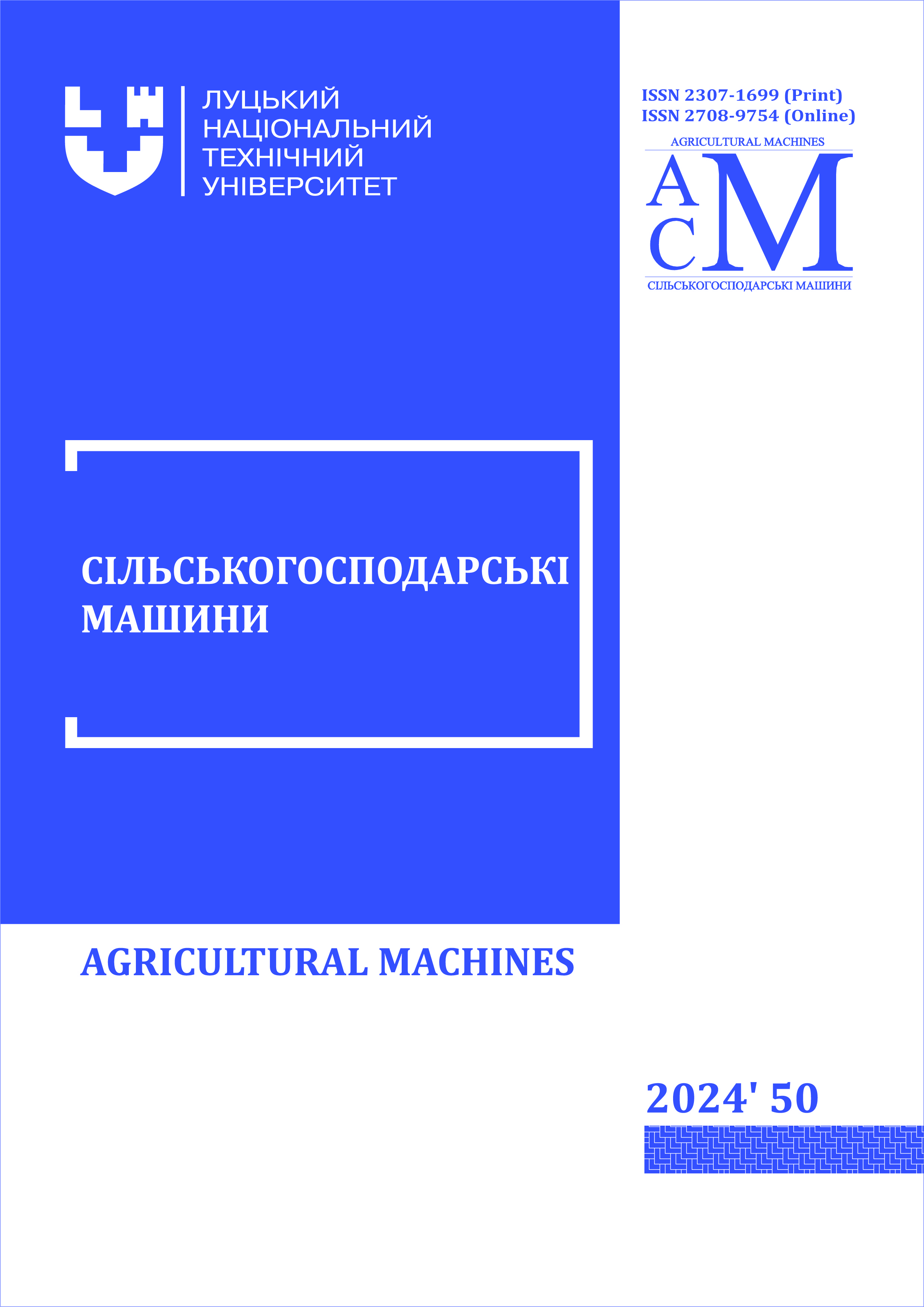JUSTIFICATION OF GROVE-LIKE ROD SHAPE OF THE SOIL TILLAGE UNIT FOR PRE-SOWING PROCESSING
Abstract
To prepare the soil for sowing, tillers with a horizontal or vertical rotation axis of the working body are used. Horizontal rotary working bodies make it possible to form three horizontal layers relative to the arable horizon with different contents of soil aggregates. In order to ensure the simultaneous grinding and separation of the soil, it is necessary to justify the shape and geometric dimensions of the working body of the tillage module for pre-sowing tillage. The method of bionic engineering was used to determine the most rational shape. For this purpose, the locomotion and biomechanics of the soil fauna were considered, namely the process of interaction of animal claws with the soil. To determine the degree of soil grinding, a refined mathematical model of A. M. Panchenko was used, which allows researchers to analyze the work of active bodies that perform both translational and rotational motion. Taking into account the proposed model of soil grinding, a geometric calculation of the shape of the rod of the bionic tillage unit for pre-sowing tillage was carried out based on the morphology of the claws of soil fauna animals, and its three-dimensional model was built. Animal claws were approximated using reverse engineering methods. The equations describing the outer and inner surfaces of the claw-shaped rod of the soil tillage unit for pre-sowing tillage were obtained by solving the condition of ensuring the maximum degree of soil grinding in the Wolfram Cloud software package using the FindMaximum function. The results of the calculation of the shape of the claw-like rod of the bionic tillage unit will be used to make an experimental sample of the equipment and further check the quality of soil grinding.
References
Babitsky, L. F., Sobolevsky, I. V., & Kuklin, V. A. (2020). Bionic modelling of the working bodies of machines for surface tillage. IOP Conf. Series: Earth and Environmental Science, 488, 012041. https://doi.org/10.1088/1755-1315/488/1/012041
Baeckens, S., Goeyers, C., & Van Damm, R. (2020). Convergent evolution of claw shape in a transcontinental lizard radiation. Integrative and Comparative Biology, 60(1), 10-23. https://doi.org/10.1093/icb/icz151
Kalinitchenko, V. P., Glinushkin, A. P., Sharshak, V. K., Ladan, E. P., Minkina, T. M., Sushkova, S. N., Mandzhieva, S. S., Batukaev, A. A., Chernenko, V. V., & Ilyina, L. P. (2021). Intra-soil milling for stable evolution and high productivity of kastanozem soil. Processes, 9, 1302. https://doi.org/10.3390/pr9081302
Li, L., Sun, W., Guo, C., Guo, H., Lili, L., & Yu, P. (2022). Mathematical model and nanoindentation properties of the claws of Cyrtotrachelus buqueti Guer (Coleoptera: Curculionidae). IET Nanobiotechnol, 16, 211-224. https://doi.org/10.1049/nbt2.12089
Matin, Md. A., Hossain, Md. I., Gathala, M. K., Timsina, J., & Krupnik, T. J. (2021). Optimal design and setting of rotary strip-tiller blades to intensify dry season cropping in Asian wet clay soil conditions. Soil and Tillage Research, 207, 104854. https://doi.org/10.1016/j.still.2020.104854
Pingyuan, X., Zhou, Y., Zhiquan, S., Qianqian, Z., Yangqing, H., & Zhuowei, Z. (2018). Simulation analysis and experiment for three-axis working resistances of rotary blade based on discrete element method. Transactions of the Chinese Society of Agricultural Engineering (Transactions of the CSAE), 34(18), 113-121. https://doi.org/10.11975/j.issn.1002-6819.2018.18.014
Toscano, P., Brambilla, M., Cutini, M., & Bisaglia, C. (2022). The stony soils reclamation systems in agricultural lands: A review. Agricultural Sciences, 13, 500-519. https://doi.org/10.4236/as.2022.134034
Tsang, L. R., Wilson, L. A. B., Ledogar, J., Wroe, S., Attard, M., & Sansalone, G. (2019). Raptor talon shape and biomechanical performance are controlled by relative prey size but not by allometry. Scientific Reports, 9, 7076. https://doi.org/10.1038/s41598-019-43654-0
Tu, C., Li, J., Wang, X., Shen, C., & Li, J. (2021). Bionic technology and deep learning in agricultural engineering: current status and future prospects. American Journal of Biochemistry and Biotechnology, 17(2), 217-231. https://doi.org/10.3844/ajbbsp.2021.217.231
Wang, L., Xing, J., He, X., Li, X., Guo, W., Wang, X., & Hou, S. (2023). Study on the mechanism of motion interaction between soil and a bionic hole-forming device. Agriculture, 13, 1421. https://doi.org/10.3390/agriculture13071421
Xu, G., Xie, Y., Liang, L., Ding, Q., Xie, H., & Wang, J. (2022). Straw-soil-rotary blade interaction: interactive effects of multiple operation parameters on the straw movement. Agronomy, 12, 847. https://doi.org/10.3390/agronomy12040847
Yang, Y., Li, M., Tong, J., & Ma, Y. (2018). Study on the Interaction between soil and the five-claw combination of a mole using the discrete element method. Applied Bionics and Biomechanics, 7854052. https://doi.org/10.1155/2018/7854052
Yang, Y., Tong, J., Huang, Y., Li, J. & Jiang, X. (2021). Impact of the multi-claw combination on the soil-cutting performance of Scaptochirus moschatus (Mammalia, Soricomorpha, Talpidae). Rendiconti Lincei. Scienze Fisiche e Naturali, 32, 869-879. https://doi.org/10.1007/s12210-021-01032-x
Yongxiang, L. (2004). Significance and progress of bionics. Journal of Bionic Engineering, 1(1), 1-3. https://doi.org/10.1007/BF03399448
Zhang, Z., Song, Y., Ren, L., & Zhang, H. (2020). Research on simulation analysis of soil cutting process by ditcher. Journal of Physics: Conference Series, 1550, 042003. https://doi.org/10.1088/1742-6596/1550/4/042003
Zhang, J., Xia, M., Chen,W., Yuan, D., Wu, C., & Zhu, J. (2023a). Simulation analysis and experiments for blade-soil-straw interaction under deep ploughing based on the discrete element method. Agriculture, 13, 136. https://doi.org/10.3390/agriculture13010136
Zhang, X., Zhang, L., Hu, X., Wang, H., & Shi, X. (2023b). Calibrating contact parameters of typical rotary tillage components cutting soil based on different simulation methods. Scientific Reports, 13, 5757. https://doi.org/10.1038/s41598-023-32881-1
Zhang, Z., Zhang, Y., Zhang, J., & Zhu, Y. (2019). Structure, mechanics and material properties of claw cuticle from mole cricket Gryllotalpaorientalis. PLOS ONE, 14(9), e0222116. https://doi.org/10.1371/journal.pone.0222116
Кочеткова, І. Б., & Сушко, Л. Ф. (2013). Вища математика в формулах та таблицях (Higher Mathematics in Formulas and Tables). Дніпропетровськ: НМетАУ.
Панченко, А. Н. (1999). Теория измельчения почв почвообрабатывающими орудиями (Theory of Soil Grinding With Tillage Tools). Днепропетровск: ДГАУ.











